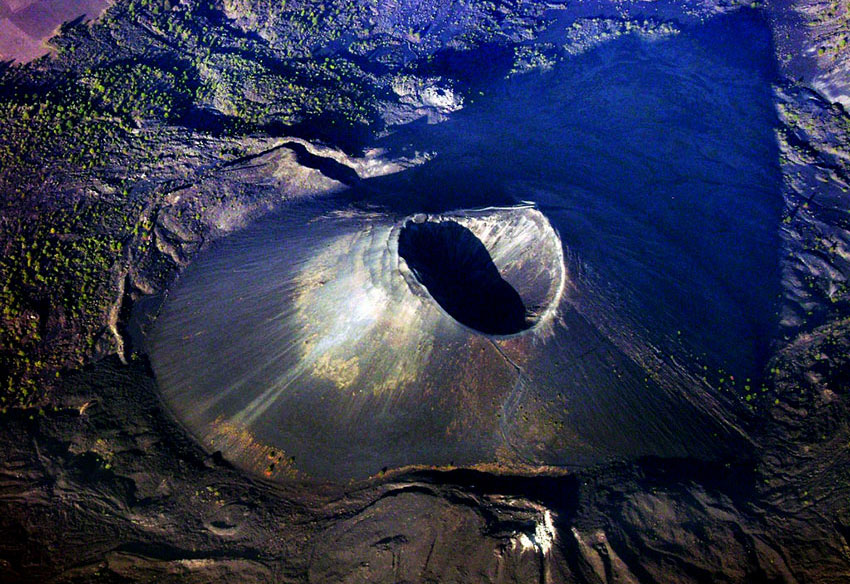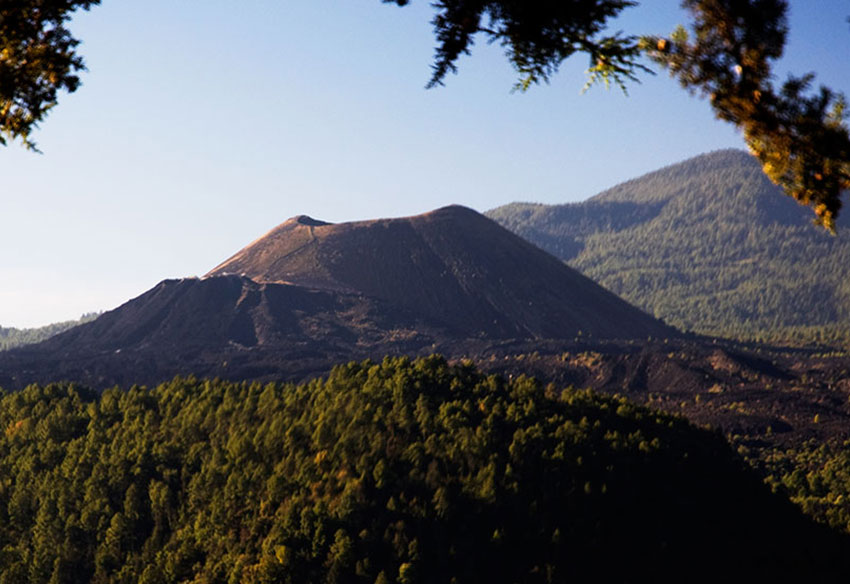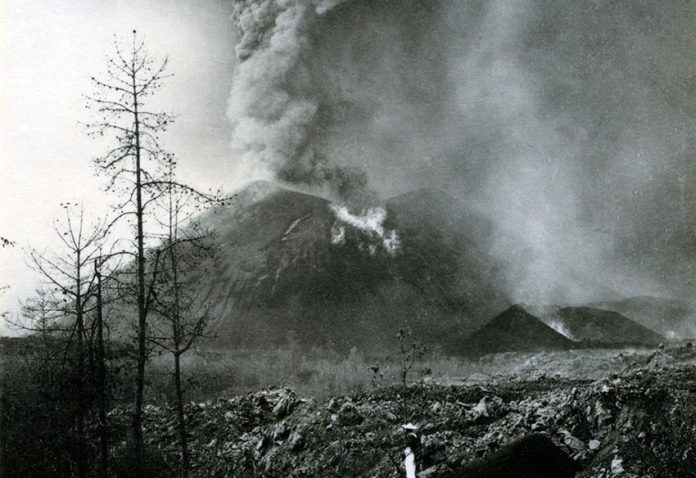Don Raymundo Acosta of Angahuan was a lad of 15 in 1943 when a mini-volcano two meters high popped up in the cornfield of one Dionisio Pulido of the nearby village of Paricutín, shaking the earth with tremors and fiercely blowing fireworks into the sky.
The volcano eventually rose to a height of 410 meters, spewing lava over an area of 20 square kilometers of Michoacán and drawing the attention of volcanologists everywhere in the world.
“One of those volcanologists was quite extraordinary because he was also a great painter,” Don Raymundo commented to me. “His name was Gerardo Murillo and he was a wonderful artist as well as my good friend. He actually camped out in the cornfield even though he was right in the path of the lava.”
Eventually Murillo, popularly known as “Dr. Atl,” gained fame both as an expert on volcanoes (he wrote How a Volcano is Born and Grows – Paricutín), and also as the precursor of Mexico’s muralists.
Paricutín is the youngest of more than a thousand volcanic vents lying along the trans-Mexican volcanic belt, but what makes it unique is the fact that its entire “life cycle,” from birth to extinction, could be witnessed and studied by scientists. In 1997 it was listed among CNN’s Seven Natural Wonders of the World, alongside the Grand Canyon and Mount Everest.

In 1975 I rode a country bus into Angahuan. I was the only person on the bus who did not speak Purépecha and I was greatly impressed by the melodic sound of this curious language, whose closest relatives are Zuni and Quechua, and which to me sounded like the gentle tinkling of bells.
My aim was to visit a church, said to be half buried in the lava, and I truly had to follow my nose to do it, because there were no signs, no refresco vendors, no eager guides to show me the way. Halfway through a flat pine forest with trails going every which way, I came upon a skinny dog whose fur was the same color as the dark volcanic ash which covered every inch of the area. I called the dog Cenizas (Ashes) and we immediately became traveling companions.
Man’s Best Friend, however, showed his true colors when I placed my knapsack on the ground and opened it up. The moment a sandwich came to light, Cenizas flashed in like a bolt of lightning and gobbled it down. I had to climb a tree in order to find a safe refuge where I could eat the other one.
Eventually I found my way through the woods and located the lonely church tower which — without the snack and souvenir vendors of today — jutted from the lava like an apocalyptic symbol of the awesome power of nature and the foolishness and frailty of man.
I didn’t get any farther on that occasion, but 10 years later I convinced family and friends that we had to go camp in that famous pine forest so we could climb the volcano. At that time there was nothing remotely like a hotel in the area.
We carefully drove along a brecha consisting entirely of soft black ash and pitched our tents. The next morning my brother William and I had one of those brilliant ideas that should never be allowed to germinate. We had brought along plenty of coffee beans which we planned to grind using nothing but Paricutín basalt.

We easily found a large rock with a bowl-shaped surface as well as a flat stone to use as a mano, but oh how quickly we discovered that the art of grinding was a skill neither of us possessed! One bean at a time was slowly reduced to powder as the minutes ticked away and our empty stomachs grumbled in protest.
“What about the coffee?” shouted my wife Susy and her sister. “Er, maybe another hour,” we replied.
At long last, we accumulated enough of the precious powder to make our brew. As the coffee dripped through the filter, along came a Swiss tourist. Eyeing the coffee-colored rock in front of which we were kneeling, he logically inquired, “Vat are you doingk?”
“Ah, we are paying homage to the old gods. Would you like to taste our volcanic coffee?”
“Danke,” said the Swiss, who then filled his unfortunately large cup right to the brim, instantly using up 90% of our morning’s production. I dare not print the ladies’ comments on our goodwill gesture, but I’m sure that day represented the high point in Mexico-Swiss relations for the entire year.
Fortified by a few meager drops of volcano-ground coffee, we set off for Paricutín’s most celebrated site, El Templo de San Juan Parangaricutiro, forever buried in lava except for its towers, which still stand tall — albeit a bit crooked — after all these years.

Although you may never succeed in pronouncing the name of this church, you can nevertheless climb down inside of it if you wish, and perhaps add a candle or flower to those decorating an image now known as the Christ of the Miracles, so called because it appears that the lava stopped right before it. Near the image there are chunks of volcanic rubble (instead of pews) upon which you can sit down and contemplate the mystery of why the painting was miraculously spared, but not the templo.
From the church we headed for the volcano itself, but we barely had time to climb the smaller cone next to Paricutín and to experience the strange sensation of hot gases shooting up our pant legs. Suddenly it was nearly sunset so we decided to head straight for our campsite, which we could see in the distance.
Alas, we learned the hard way that a straight line is not the shortest distance in a lava field. Every step we took was precarious; every chunk of lava twisted and turned beneath our feet, threatening a broken leg; many large pieces weighing hundreds of kilos were so delicately balanced that a touch could make them fall.
We seemed to move at a snail’s pace. On top of that, our water supply had long given out. All we had between us was one orange and this we saved until the last beam of sunlight slipped beneath the craggy skyline. Ah, I will never forget the celestial taste of my half of that orange, nor the arrival of the ladies at our campsite — when we finally got there — leading a burro carrying a full case of cold beer, most of which we gulped down within an hour.
As the years passed, development took place and today you’ll probably have a hard time getting lost or thirsty at Paricutín. It seems every living soul in Angahuan is now a professional guide and everywhere you turn there’s a restaurant or a hotel. Walking is no longer necessary as you can now rent a horse which, after a long ride, will deposit you at the foot of the volcano.
From there you should reach the crater lip in less than an hour, even though, as a 9-year-old girl who tried it told me, “every step forward in the loose ash is followed by two steps back.” However, she added, the view from the top is truly magnificent and well worth the five hours in the saddle.
[soliloquy id="99068"]
The village of Angahuan is fascinating. The older houses, called trojes, are made of wood with high, steep roofs; the 16th-century church was designed by a Moorish stonemason; and the women still wear colorful rebosos. All day long, visitors to the area will hear what sounds like chant coming out of powerful loudspeakers located in four different parts of Angahuan. All of it is in Purépecha and believe it or not, all of it is advertising.
The thundering speakers sing the praises of Doña María’s delicious corundas (a kind of tamal) and Doña Carmelita’s scrumptious buchepos (another kind of tamal). Unfortunately, all the loudspeakers bellow simultaneously, producing a cacophony that starts at 7:00am and continues until the last potential customer hits the sack. So much for the myth of the peaceful Indian village.
Paricutín volcano lies between Guadalajara and Mexico City. It can be reached in about five hours from the former, while from CDMX the drive will take closer to seven hours. I think it can be truly said that this site is unique in all the world. Visit it and, like Don Raymundo Acosta, you too will have a few tales to tell your great-grandchildren.
The writer has lived near Guadalajara, Jalisco, for more than 30 years and is the author of A Guide to West Mexico’s Guachimontones and Surrounding Area and co-author of Outdoors in Western Mexico. More of his writing can be found on his website.
